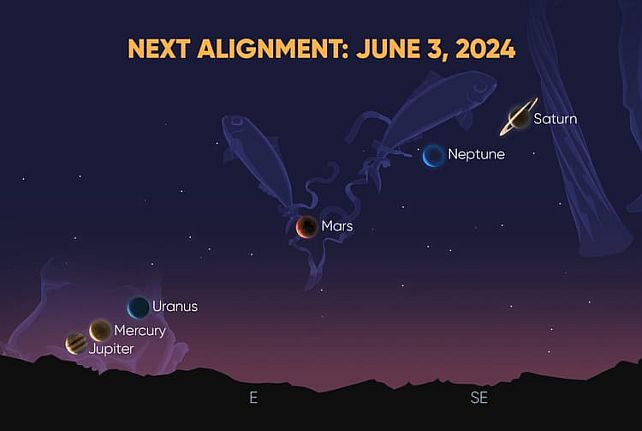A Planetary Alignment Will Appear in the Sky Next Week
![]()
Astrophotographers ready yourselves: a planetary alignment involving Mercury, Mars, Jupiter, Saturn, Neptune, and Uranus will appear in the sky in the coming days.
In the small hours of June 3 and June 4 (Monday and Tuesday), six planets will parade in the sky as well as a bonus of a waning crescent Moon.
However, it will be quite the challenge to get them all in one shot owing to their various degress of visibility and therefore likely to require some clever compositing.
But the effort might be worth it because the planets will be in a straight line, it is not uncommon for multiple planets to be in the sky but rare to be able to draw a diagonal line from Jupiter to Saturn.
Preston Dyches of NASA’s Skywatching Tips video series tells Phys that Mercury and Jupiter will be very low in the sky and difficult to spot.
“Contrary to many reports and social media postings, there will not be a string of naked-eye planets visible on June 3,” Dyches says.
“Mercury and Jupiter will be far too low in the sky at sunrise. Even under ideal conditions (a dark sky, free from light pollution), Uranus is very dim and challenging to spot. The skyglow near dawn makes matters worse.”

The alignment occurs because all of the Solar System’s planets orbit the Sun on a flat plane known as the ecliptic.
According to Science Alert, when planets congregate on the same side of the Sun as part of their natural orbit, people on Earth get to see them all at the same time.
This is what is happening in early June but as Dyches says, not all the planets will be easy to see. He says the “real parade” will be later this month when Mars, Jupiter, Saturn, and the Moon will be visible to the naked eye at around 05:00.
“If you went out that morning, you could actually see all of those four objects at the same time, and that’s not really the same for the June 3 thing,” he adds.
Time and Date has an interactive tool allowing you to find the exact timings of planetary rises so you can prepare accordingly.
For tips on astrophotography, check out PetaPixel’s guide.